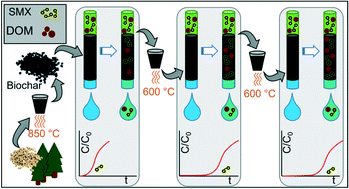当前位置:
X-MOL 学术
›
Environ. Sci.: Water Res. Technol.
›
论文详情
Our official English website, www.x-mol.net, welcomes your feedback! (Note: you will need to create a separate account there.)
Influence of biochar thermal regeneration on sulfamethoxazole and dissolved organic matter adsorption
Environmental Science: Water Research & Technology ( IF 5 ) Pub Date : 2017-11-22 00:00:00 , DOI: 10.1039/c7ew00379j Benjamin G. Greiner 1, 2, 3, 4 , Kyle K. Shimabuku 1, 2, 3, 4 , R. Scott Summers 1, 2, 3, 4
Environmental Science: Water Research & Technology ( IF 5 ) Pub Date : 2017-11-22 00:00:00 , DOI: 10.1039/c7ew00379j Benjamin G. Greiner 1, 2, 3, 4 , Kyle K. Shimabuku 1, 2, 3, 4 , R. Scott Summers 1, 2, 3, 4
Affiliation

|
Biochar is emerging as a cost-effective, environmentally-sustainable adsorbent for removing organic contaminants (OC) from wastewater, stormwater, and drinking water, but strategies for managing exhausted biochar are needed. Here, pine biochar generated at 850 °C was exhausted by background dissolved organic matter isolated from surface water [dissolved organic carbon ∼4.2 mg L−1, UV-absorbance at 254 nm (UVA254) ∼0.10 cm−1] and sulfamethoxazole (SMX) [∼200 ng L−1], in a column. Exhausted biochar underwent a semi-oxic-thermal-regeneration step at 600 °C (i.e., heat treatment). SMX and UVA254 adsorption capacity and breakthrough were evaluated in rapid small-scale column tests (RSSCTs). Relative to fresh biochar, heat treated biochar that had been exhausted exhibited ∼3.5-fold and ∼3-fold greater SMX and UVA254 adsorption capacities, respectively, and ∼3-fold increase in adsorption efficiency (i.e., mass loss-adjusted SMX adsorption capacity). When applying the heat treatment to fresh biochar, a similar improvement in adsorption capacity was observed. Adsorption capacity and BET surface area were positively correlated and continued to increase after a second exhaustion–regeneration cycle, but the adsorption efficiency remained the same due to mass loss. SMX breakthrough correlated with that of UVA254, which provides the basis for a rapid, inexpensive method to predict OC breakthrough. Heat-treated biochar's SMX adsorption capacity was ∼20% of activated carbon's. Greater empty-bed-contact times increased the SMX adsorption capacity of heat-treated biochar. These results suggest that thermal regeneration could enhance the economic and environmental sustainability of biochar sorbents.
中文翻译:

生物炭热再生对磺胺甲恶唑和溶解性有机物吸附的影响
生物炭正在成为一种具有成本效益,对环境可持续的吸附剂,可从废水,雨水和饮用水中去除有机污染物(OC),但是需要管理用尽的生物炭的策略。在这里,在850℃下产生的松生物炭通过从表面水隔离背景溶解有机物[溶解的有机碳~4.2毫克的L用尽-1,UV吸光度在254nm(UVA 254)~0.10厘米-1 ]和磺胺甲恶唑( SMX)[〜200 ng L -1 ],在列中。耗尽的生物炭在600°C下进行半有氧热再生(即热处理)。SMX和UVA 254在快速小型色谱柱试验(RSSCT)中评估了吸附能力和突破。相对于新鲜生物炭,已用尽的热处理过的生物炭分别显示出约3.5倍和约3倍的SMX和UVA 254吸附能力,并增加了约3倍的吸附效率(即,质量损失调整后的SMX吸附)容量)。当将热处理应用于新鲜生物炭时,观察到吸附能力的类似提高。吸附能力和BET表面积呈正相关,并在第二次疲劳-再生循环后继续增加,但由于质量损失,吸附效率保持不变。SMX突破与UVA 254的突破,这为预测OC突破的快速,廉价方法提供了基础。热处理过的生物炭的SMX吸附量约为活性炭的20%。更长的空床接触时间增加了热处理生物炭的SMX吸附能力。这些结果表明,热再生可以增强生物炭吸附剂的经济和环境可持续性。
更新日期:2017-11-28
中文翻译:

生物炭热再生对磺胺甲恶唑和溶解性有机物吸附的影响
生物炭正在成为一种具有成本效益,对环境可持续的吸附剂,可从废水,雨水和饮用水中去除有机污染物(OC),但是需要管理用尽的生物炭的策略。在这里,在850℃下产生的松生物炭通过从表面水隔离背景溶解有机物[溶解的有机碳~4.2毫克的L用尽-1,UV吸光度在254nm(UVA 254)~0.10厘米-1 ]和磺胺甲恶唑( SMX)[〜200 ng L -1 ],在列中。耗尽的生物炭在600°C下进行半有氧热再生(即热处理)。SMX和UVA 254在快速小型色谱柱试验(RSSCT)中评估了吸附能力和突破。相对于新鲜生物炭,已用尽的热处理过的生物炭分别显示出约3.5倍和约3倍的SMX和UVA 254吸附能力,并增加了约3倍的吸附效率(即,质量损失调整后的SMX吸附)容量)。当将热处理应用于新鲜生物炭时,观察到吸附能力的类似提高。吸附能力和BET表面积呈正相关,并在第二次疲劳-再生循环后继续增加,但由于质量损失,吸附效率保持不变。SMX突破与UVA 254的突破,这为预测OC突破的快速,廉价方法提供了基础。热处理过的生物炭的SMX吸附量约为活性炭的20%。更长的空床接触时间增加了热处理生物炭的SMX吸附能力。这些结果表明,热再生可以增强生物炭吸附剂的经济和环境可持续性。



























 京公网安备 11010802027423号
京公网安备 11010802027423号